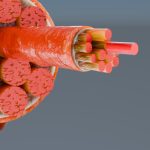Types of cardiovascular training vary in nature according to their intended outcome(s). Is the client attempting to enhance peak performance, or simply to improve or maintain his or her level of general fitness?
It is important to have the answer to that question firmly in mind when planning the cardio component of any exercise program.
Cardiovascular Training Exclusively
There is a common and persistent popular misconception that any amount of weight training necessarily results in large muscles, inflexibility, compromised athletic performance, etc. What is not as often mentioned are the lost advantages from not performing resistance training along with cardio. Some of those include an increased risk of injury, weak muscles, lost lean weight (along with the lilkelihood of fat accumulation), and poor muscle tone. The fact is that while using cardio alone and while on a strict diet, muscle will be catabolized and used for energy in place of fat since the body will desire to maintain fat for survival during the existing low calorie diet. If muscles are not made to work, the body will regard them as expendable.
Performing Aerobics at the Same Intensity Level
Aerobic activity duration and intensity are the two primary variables that shape the results of this type of training. If the participant performs aerobic activity for the same duration and at the same intensity, the body will quickly adapt and further enhancement is impossible. There may still be some merit to performing this types of exercise for the purpose of general fitness, but not for peak functional fitness. For peak functional fitness, which is desirable by the cross training athlete, aerobics should be performed in cycles of different intensity levels. Depending upon the athlete and the desired result, a particular level of intensity may be more productive than others.
Consider the four main modes of cardiorespiratory activity:
A. Low intensity for long durations;
B. Alternating high and low intensities over equal durations;
C. Short recovery between bursts of maximum intensity;
D. Steady State Target Heart Rate Aerobics.
A. Low Intensity, Long Duration:
It is generally recommended that this mode of aerobic work be performed for at least 40-45 minutes per session. Mobilized fat accounts for a greater share energy supply during this type of activity. The comparartively long duration of this activity allows fatty acids to more completely perfuse into even the smallest of capillary beds, thereby fueling the working muscles and optimizing fat loss and oxygenation. It is also important to note that muscle cellular organelles known as mitochondria become more efficient at burning fatty acids for ATP.
B. Alternating High and Low Intensities over Equal Durations
This type of aerobic training effect requires the participant to perform at a level of intensity that can just barely be maintained for periods of no longer than 5-10 minutes alternated with 5-10 minutes of low intensity output. The aerobic power threshold and lactate threshold increases when performing this activity. In effect, there is an increase in the duration of a participant’s ability to work at maximum effort. This has obvious benefits for athletes involved in sports that require repeated short bursts of near maximum effort. By increasing the lactate threshold, an athlete is better able to perform high intensity work longer even during events that call for a degree of endurance. What is particularly interesting is that this result is consistent regardless of the sporting event.
Since this higher intensity activity requires more glucose energy, the muscles adapt by building more glucose energy-burning mitochondria. At the same time, the muscles become more efficient at transporting and utilizing insulin-carried glucose from the bloodstream, and converting lactic acid back into energy. In general, this mode of training increased the efficiency of a muscle’s ability to use all of the related aerobic and anaerobic energy fuels and pathways.
This type of training could be thougt of as offering the most holistic approach to total cardiorespiratory conditioning.
C. Short Recovery between Bursts of Maximum Intensity
The main differences between this type of training and the alternation of near-maximal work with equal durations of submaximal work is that the intensity is maximal and the recovery (five minutes or more, depending on how the participant feels), calls for complete rest. To achieve VO2 max, the effort must be intense enough that it cannot be performed for longer than 1.5 to 3 minutes while subsequently reaching near complete failure. Adaptation includes the improvement of VO2 max, the heart muscle becomes stronger and can pump more blood per contraction, the muscles’ anaerobic energy producing pathways become more efficient, and their is an improvement in the body’s ability to remove, convert, and tolerate lactic acid.
It is necessary to understand that this type of training is not for everyone, and it critically important to pay close attention to the contraindications to exercise–don’t overdo things!
This type of training can be beneficial for athletes who are called upon to perform short bursts at maximal effort–such as a football linebacker.
The above aerobic training modes take the participant into the area of peak functional fitness. However, it is important to bear in mind that performing aerobic exercise exclusively is not a good idea if someone wish to achieve his or her potential peak level of functional or athletic fitness. In order to increase intensity, is it necessary to either increase speed or incline. This will shift the energy pathway to the stores in the muscles.
Structuring an Aerobic Program
With the above points in mind, how does one structure an aerobic program? It is suggested that the participant target these modes progressively (modes from A thru C), focusing on each mode for a period of 4-6 weeks before progressing. It is also recommended also that the participant include a long duration, low intensity component at least once each week. It is appropriate to realize there is potential for over-use injury in even the best-planned aerobic component of a functional cross training routine.
Cross Training and/or Specificity Training
There is tremendous intrinsic value in changing up activities such as cycling, running, skiing, swimming, etc., especially if you someone is not committed to a specific sport.
For someone who is committed to a particular sport, one of the best ways to improve skills specific to that sport is to perform the motions used in that activity. In other words, to be a better basketball player, put the greatest emphasis on playing basketball, if you wish to be a better football player, put more emphasis on position-based training. Regardless, some occasional variety in sport involvement will always be helpful even for someone who is committed to a particullar sport.
D. Steady State Target Heart Rate Aerobics
Perhaps the most widely known and practiced modes of cardio training is so-called steady state, or target heart rate (THR), aerobics. The Target Heart Rate method of training lacks the intensity to improve anaerobic pathways for continued adaptation and lacks the duration to result in optimum fat loss.
For a client who is interested in cross training and athletic conditioning, it may be advisable to avoid this conditioning method, were it not for some possible value in preparing the athlete participant for a progressive cardio program moving towards the performance of the above mentioned athletic training modes.
This type of cardio training leads to little, if any, adaptation in terms of athletic enhancement. Using the formula .70 x Max HR=Target HR will result in a short term adaptation, at best. However, it can be continuously performed by a general fitness enthusiast whose goal it is to simply stay fit–likely one of the main reasons for its widespread popularity. With that said, the continued performance of this approach to aerobic fitness is not functional because no one truly functions this way in either going about his or her daily life or in athletic performance.
Reference
1. Personal Fitness Trainer Manual: The Fundamentals for the Certified Personal Trainer (CPT) (Fifth Edition, 2008). The National Federation of Professional Trainers.
2. Weinberg, Robert and Daniel Gould. Foundations of Sport and Exercise Psychology (Fifth Edition). Human Kinetics.






